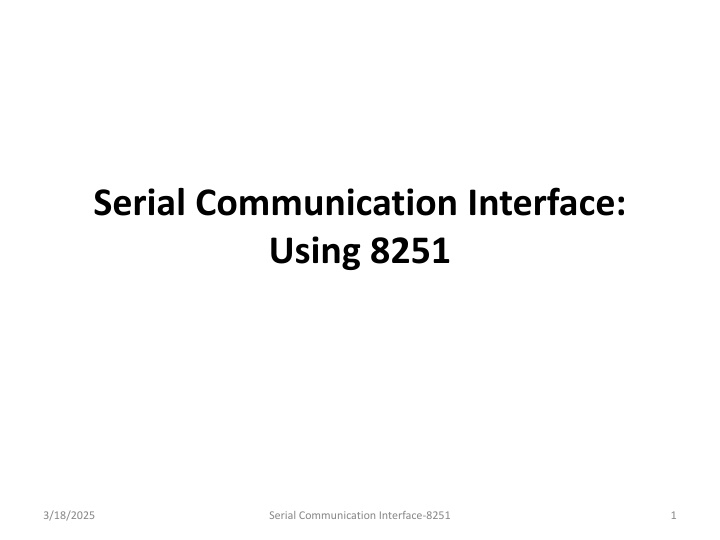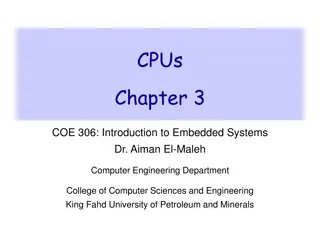
The 8251 Serial Communication Interface: Modes, Signals, and Operation
Delve into the world of serial communication with the versatile 8251 interface, capable of synchronous and asynchronous data transfer in simplex, duplex, and half-duplex modes. Explore its basic modes, signal descriptions, and operation in communicating with processors and peripherals.
Download Presentation

Please find below an Image/Link to download the presentation.
The content on the website is provided AS IS for your information and personal use only. It may not be sold, licensed, or shared on other websites without obtaining consent from the author. If you encounter any issues during the download, it is possible that the publisher has removed the file from their server.
You are allowed to download the files provided on this website for personal or commercial use, subject to the condition that they are used lawfully. All files are the property of their respective owners.
The content on the website is provided AS IS for your information and personal use only. It may not be sold, licensed, or shared on other websites without obtaining consent from the author.
E N D
Presentation Transcript
Serial Communication Interface: Using 8251 3/18/2025 Serial Communication Interface-8251 1
8251 Basic modes of data transfer Signals / Pins Different mode Block Diagram of 8251 Operating modes of 8251 3/18/2025 Serial Communication Interface-8251 2
8251 is a Universal Synchronous and Asynchronous Receiver and Transmitter compatible with Intel s processors. This chip converts the parallel data into a serial stream of bits suitable for serial transmission. It is also able to receive a serial stream of bits and convert it into parallel data bytes to be read by a microprocessor. 3/18/2025 Serial Communication Interface-8251 3
Basic Modes of data transmission a) Simplex b) Duplex c) Half Duplex 3/18/2025 Serial Communication Interface-8251 4
Simplex mode Data is transmitted only in one direction over a single communication channel. For example, the processor may transmit data for a CRT display unit in this mode. Duplex Mode In duplex mode, data may be transferred between two transceivers in both directions simultaneously. Half Duplex mode In this mode, data transmission may take place in either direction, but at a time data may be transmitted only in one direction. A computer may communicate with a terminal in this mode. It is not possible to transmit data from the computer to the terminal and terminal to computer simultaneously. 3/18/2025 Serial Communication Interface-8251 5
Signal Description of 8251 D0 D7: This is an 8-bit data bus used to read or write status, command word or data from or to the 8251A. C / D: (Control Word/Data): This input pin, together with RD and WR inputs, informs the 8251A that the word on the data bus is either a data or control word/status information. If this pin is 1, control is on the bus, otherwise data is on the bus. RD: This active-low input to 8251A is used to inform it that the CPU is reading either data or status information from its internal registers. WR: This is an active-low chip select input of 825lA. If it is high, no read or write operation can be carried out on 8251. 3/18/2025 Serial Communication Interface-8251 6
CLK: This input is used to generate internal device timings and is normally connected to clock generator output. This input frequency should be at least 30 times greater than the receiver or transmitter data bit transfer rate. RESET: A high on this input forces the 8251A into an idle state. The device will remain idle till this input signal again goes low and a new set of control word is written into it. The minimum required reset pulse width is 6 clock states, for the proper reset operation. TXC (Transmitter Clock Input): This transmitter clock input controls the rate at which the character is to be transmitted. The serial data is shifted out on the successive negative edge of the TXC. TXD (Transmitted Data Output): This output pin carries serial stream of the transmitted data bits along with other information like start bit, stop bits and parity bit, etc. 3/18/2025 Serial Communication Interface-8251 7
RXC (Receiver Clock Input): This receiver clock input pin controls the rate at which the character is to be received. RXD (Receive Data Input): This input pin of 8251A receives a composite stream of the data to be received by 8251 A. RXRDY (Receiver Ready Output): This output indicates that the 8251A contains a character to be read by the CPU. TXRDY - Transmitter Ready: This output signal indicates to the CPU that the internal circuit of the transmitter is ready to accept a new character for transmission from the CPU. 3/18/2025 Serial Communication Interface-8251 8
DSR - Data Set Ready: This is normally used to check if data set is ready when communicating with a modem. DTR - Data Terminal Ready: This is used to indicate that the device is ready to accept data when the 8251 is communicating with a modem. RTS - Request to Send Data: This signal is used to communicate with a modem. TXE- Transmitter Empty: The TXE signal can be used to indicate the end of a transmission mode. 3/18/2025 Serial Communication Interface-8251 9
Block Diagram of 8251 3/18/2025 Serial Communication Interface-8251 10
The data buffer interfaces the internal bus of the circuit with the system bus. The read / write control logic controls the operation of the peripheral depending upon the operations initiated by the CPU decides whether the address on internal data bus is control address / data address. The modem control unit handles the modem handshake signals to coordinate the communication between modem and USART. The transmit control unit transmits the data byte received by the data buffer from the CPU for serial communication. The transmission rate is controlled by the input frequency. Transmit control unit also derives two transmitter status signals namely TXRDY and TXEMPTY which may be used by the CPU for handshaking. 3/18/2025 Serial Communication Interface-8251 11
The transmit buffer is a parallel to serial converter that receives a parallel byte for conversion into a serial signal for further transmission. The receive control unit decides the receiver frequency as controlled by the RXC input frequency. The receive control unit generates a receiver ready (RXRDY) signal that may be used by the CPU for handshaking. 3/18/2025 Serial Communication Interface-8251 12
Operating Modes of 8251 1. Asynchronous mode 2. Synchronous mode Asynchronous Mode (Transmission) When a data character is sent to 8251A by the CPU, it adds start bits prior to the serial data bits, followed by optional parity bit and stop bits using the asynchronous mode instruction control word format. This sequence is then transmitted using TXD output pin on the falling edge of TXC. 3/18/2025 Serial Communication Interface-8251 13
Asynchronous Mode (Receive) A falling edge on RXD input line marks a start bit. The receiver requires only one stop bit to mark end of the data bit string. The 8-bit character is then loaded into the into parallel I/O buffer of 8251. RXRDY pin is raised high to indicate to the CPU that a character is ready for it. If the previous character has not been read by the CPU, the new character replaces it, and the overrun flag is set indicating that the previous character is lost. 3/18/2025 Serial Communication Interface-8251 14
Synchronous Mode (Transmission) The TXD output is high until the CPU sends a character to 8251 which usually is a SYNC character. When CTS line goes low, the first character is serially Characters are shifted out on the falling edge of TXC . transmitted out. 3/18/2025 Serial Communication Interface-8251 15
Synchronous Mode (Receiver) In this mode, the character synchronization can be achieved internally or externally. The data on RXD pin is sampled on rising edge of the RXC. The content of the receiver buffer is compared with the first SYNC character at every edge until it matches. If 8251 is programmed for two SYNC characters, the subsequent received character is also checked. When the characters match, the hunting stops. The SYNDET pin set high and is reset automatically by a status read operation. In the external SYNC mode, the synchronization is achieved by applying a high level on the SYNDET input pin that forces 8251 out of HUNT mode. 3/18/2025 Serial Communication Interface-8251 16
Status Read Definition This definition is used by the CPU to read the status of the active 8251 to confirm if any error condition or other conditions like the requirement of processor service has been detected during the operation. 3/18/2025 Serial Communication Interface-8251 17
Different Mode Control Words There are two types of control word. 1. Mode instruction (setting of function) 2. Command (setting of operation) 1) Mode Instruction Mode instruction is used for setting the function of the 8251. Mode instruction will be in "wait for write" at either internal reset or external reset. That is, the writing of a control word after resetting will be recognized as a "mode instruction." 3/18/2025 Serial Communication Interface-8251 18
Items set by mode instruction are as follows: Synchronous/asynchronous mode Stop bit length (asynchronous mode) Character length Parity bit Baud rate factor (asynchronous mode) Internal/external synchronization (synchronous mode) Number of synchronous characters (Synchronous mode) 3/18/2025 Serial Communication Interface-8251 19
3/18/2025 Serial Communication Interface-8251 20
3/18/2025 Serial Communication Interface-8251 21
2) Command Command is used for setting the operation of the 8251. It is possible to write a command whenever necessary after writing a mode instruction and sync characters. Items to be set by command are as follows: Transmit Enable/Disable Receive Enable/Disable DTR, RTS Output of data. Resetting of error flag. Sending to break characters Internal resetting Hunt mode (synchronous mode) 3/18/2025 Serial Communication Interface-8251 22
3/18/2025 Serial Communication Interface-8251 23















